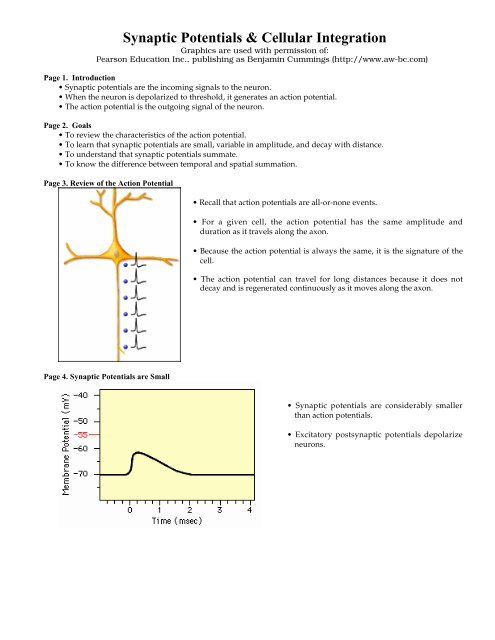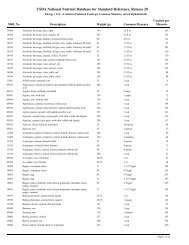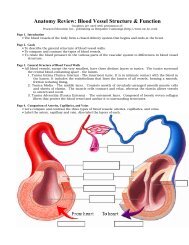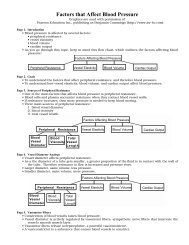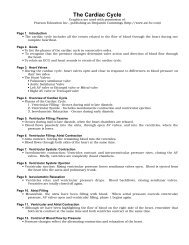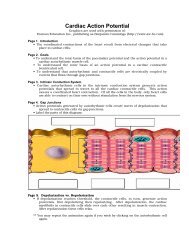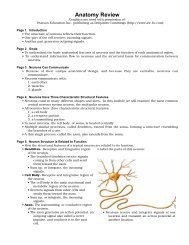Synaptic Potentials & Cellular Integration - Pearson
Synaptic Potentials & Cellular Integration - Pearson
Synaptic Potentials & Cellular Integration - Pearson
You also want an ePaper? Increase the reach of your titles
YUMPU automatically turns print PDFs into web optimized ePapers that Google loves.
<strong>Synaptic</strong> <strong>Potentials</strong> & <strong>Cellular</strong> <strong>Integration</strong>Graphics are used with permission of:<strong>Pearson</strong> Education Inc., publishing as Benjamin Cummings (http://www.aw-bc.com)Page 1. Introduction• <strong>Synaptic</strong> potentials are the incoming signals to the neuron.• When the neuron is depolarized to threshold, it generates an action potential.• The action potential is the outgoing signal of the neuron.Page 2. Goals• To review the characteristics of the action potential.• To learn that synaptic potentials are small, variable in amplitude, and decay with distance.• To understand that synaptic potentials summate.• To know the difference between temporal and spatial summation.Page 3. Review of the Action Potential• Recall that action potentials are all-or-none events.• For a given cell, the action potential has the same amplitude andduration as it travels along the axon.• Because the action potential is always the same, it is the signature of thecell.• The action potential can travel for long distances because it does notdecay and is regenerated continuously as it moves along the axon.Page 4. <strong>Synaptic</strong> <strong>Potentials</strong> are Small• <strong>Synaptic</strong> potentials are considerably smallerthan action potentials.• Excitatory postsynaptic potentials depolarizeneurons.
• Inhibitory postsynaptic potentials depolarizeneurons.* Now is a good time to go to quiz question 1:• Click the Quiz button on the left side of the screen.• Work through quiz question 1.• When you are done return to "Page 5. <strong>Synaptic</strong> <strong>Potentials</strong> Vary in Amplitude".Page 5. <strong>Synaptic</strong> <strong>Potentials</strong> Vary in Amplitude• The amplitude of a synaptic potential varies and isrelated to the number of synaptic vesicles releasingneurotransmitter.• The number of vesicles releasing neurotransmitterin turn is related to the amount of calcium thatenters the presynaptic terminal.• In some neurons, rapid firing of action potentialsallows more calcium to enter the terminal. Thiscauses enhanced postsynaptic potentials, orpotentiation, for a period of time.• Signaling at an axoaxonic synapse can decrease theentry of calcium into the presynaptic terminal.This event, called presynaptic inhibition,decreases the amplitude of a subsequentpostsynaptic potential.• When the amount of calcium entering the presynaptic terminal is altered, the synaptic potential may beenhanced, or weakened. Because they vary in amplitude, synaptic potentials are called graded potentials.Page 6. <strong>Synaptic</strong> <strong>Potentials</strong> Decay with Distance• <strong>Synaptic</strong> potentials are largest at the synapse where they originate.• <strong>Synaptic</strong> potentials decay as they travel away from the synapse.• Unlike the action potential, the synaptic potential can only travel forshort distances because it decays as it moves along the neuronalmembrane.• This effect is true for both excitatory postsynaptic potentials andinhibitory postsynaptic potentials.Page 7. EPSPs Summate
• A single action potential in a presynaptic cell leadsto an excitatory postsynaptic potential, which is toosmall to depolarize a neuron to threshold.• The neuron can summate, or add, excitatorypostsynaptic potentials to produce a greaterdepolarization.• This is an example of temporal summation. Severalaction potentials are delivered along the same axonbut staggered in time.• Click the presynaptic axon again to see what mustoccur for depolarization to be great enough toproduce an action potential in the postsynapticneuron.• Excitatory postsynaptic potentials from synapses atdifferent sites also summate. This process is anexample of spatial summation.• Click a presynaptic axon to see how the activity ofsynapses at different sites can produce an actionpotential in the postsynaptic neuron.• Many excitatory postsynaptic potentials arerequired to depolarize a neuron to threshold.* Don't forget to click on the Virtual professor Button.* Now is a good time to go to quiz questions 2 & 3:• Click the Quiz button on the left side of the screen.• Work through quiz questions 2 & 3.• When you are finished return to page 8 "IPSPs Summate With Each Other and With EPSPs."Page 8. IPSPs Summate With Each Other and With EPSPs• Like excitatory postsynaptic potentials, inhibitorypostsynaptic potentials also summate.• The overall effect of inhibitory activity is to keepthe membrane potential below threshold, thuspreventing the postsynaptic cell from generating anaction potential.• Inhibitory postsynaptic potentials and excitatorypostsynaptic potentials also summate with eachother.• When inhibitory potentials are added to excitatorypotentials, they reduce the magnitude of theexcitatory postsynaptic potentials.
• Inhibitory synaptic activity cancels the effects ofexcitatory activity and can prevent the postsynapticcell from generating an action potential.• Excitatory activity must travel from the synapseacross the cell body to depolarize a neuron tothreshold.• The closer a synapse is to the trigger zone or axonhillock, the greater the effectiveness of that synapse.In the brain, inhibitory synapses are often locatedon the cell body, where they can have the mostpowerful effect.Page 9. The Neuron Integrates All <strong>Synaptic</strong> Information• Neurons are like democracies.• Like thousands of voters, the synapses signal their aye or nay votes,and the neuron counts them all.• If the aye votes prevail, the neuron generates an action potential.• If the nay votes prevail, the neuron remains silent.• The process by which a neuron tallies the votes is called cellularintegration.• This process goes on continually as neurons determine whether ornot to produce action potentials.• This neuronal activity is very similar to the fundamental activity ofthe whole nervous system.• The integrative activity of the nervous system selects one outputfrom all the competing alternatives.Page 10. Summary• <strong>Synaptic</strong> potentials are small, graded, short-distance signals.• Many excitatory postsynaptic potentials are needed to depolarize a cell to threshold.• Inhibitory postsynaptic potentials reduce the magnitude of excitatory postsynaptic potentials.• The job of the cell, like the job of the whole nervous system, is to select a single output from many competinginputs.* Now is a good time to go to quiz question 4:• Click the Quiz button at the bottom of the screen.• Work through quiz question 4.Notes on Quiz Questions:Quiz Question #1: Action <strong>Potentials</strong> vs. <strong>Synaptic</strong> <strong>Potentials</strong>• This question asks you to fill out a chart with respect to action potentials and synaptic potentials. You maywant to fill out this chart as you proceed:
Quiz Question #2: Temporal Summation• This question asks you to stimulate a neuron to determine which dendrite takes the longest to generate anaction potential.Quiz Question #3: Spatial Summation• This question asks you to stimulate neurons in order to determine how many EPSPs are needed forthreshold.Quiz Question #4: <strong>Cellular</strong> <strong>Integration</strong>• This question asks you to find a location for an IPSP that will inhibit an EPSP.Study Questions on <strong>Synaptic</strong> <strong>Potentials</strong> & <strong>Cellular</strong> <strong>Integration</strong>:1. (Page 1.) ____________ ___________ are the incoming signals to the neuron.a. synaptic potentials b. action potentials2. (Page 1.) When the neuron is depolarized to threshold, it generates an ________ _________. The action potential isthe outgoing signal of the neuron.a. synaptic potentials b. action potentials3. (Page 1.) Recall that action potentials are all-or-none events. For a given cell, the action potential has the same__________ and ___________ as it travels along the axon.a. amplitude and duration b. decay and fizzle out4. (Page 4.) __________ __________ are considerably smaller than ________ _________.a. synaptic potentials, action potentials b. action potentials, synaptic potentials5. (Page 4.) Excitatory postsynaptic potentials _________ neurons.a. depolarize b. hyperpolarize6. (Page 4.) Inhibitory postsynaptic potentials ___________ neurons.a. depolarize b. hyperpolarize7. (Page 4.)Which of these is a depolarization and which is a hyperpolarization?a. b.
8. (Page 5.) The amplitude of a synaptic potential varies and is related to the number of synaptic vesicles releasing______________.a. calcium b. neurotransmitter c. sodium9. (Page 5.) The number of vesicles releasing neurotransmitter in turn is related to the amount of ______ that entersthe presynaptic terminal.a. calcium b. neurotransmitter c. sodium10. (Page 5.) In some neurons, rapid firing of action potentials allows more calcium to enter the terminal. This causesenhanced ___________ _____________, or potentiation, for a period of time.a. EPSP b. IPSP c. postsynaptic potentials d. presynaptic inhibition11. (Page 5.) Signaling at an axoaxonic synapse can decrease the entry of calcium into the presynaptic terminal. Thisevent, called ________ _________, decreases the amplitude of a subsequent postsynaptic potential.a. EPSP b. IPSP c. postsynaptic potentials d. presynaptic inhibition12. (Page 5.) When the amount of ________ entering the presynaptic terminal is altered, the synaptic potential may beenhanced, or weakened. Because they vary in amplitude, synaptic potentials are called graded potentials.a. calcium b. neurotransmitter c. sodium13. (Page 6.) <strong>Synaptic</strong> potentials are largest at the synapse where they originate. <strong>Synaptic</strong> potentials _______ as theytravel away from the synapse.a. potentiate b. decay c. remain as is14. (Page 6.) Unlike the action potential, the synaptic potential can only travel for _________ ________ because itdecays as it moves along the neuronal membrane. This effect is true for both excitatory postsynaptic potentials andinhibitory postsynaptic potentials.a. short distances b. long distances15. (Page 6.) Which of these shows a graded potential and which shows an action potential?a. b.
16. (Page 7.) A single action potential in a presynaptic cell leads to an _____________ ___________ __________, whichis too small to depolarize a neuron to threshold.a. EPSP b. IPSP c. postsynaptic potentials d. presynaptic inhibition17. (Page 7.) The neuron can summate, or add, excitatory postsynaptic potentials to produce a greater____________.a. depolarization b. hyperpolarization c. EPSP d. IPSP18. (Page 7.) This is an example of _________ _________. Several action potentials are delivered along the same axonbut staggered in time.a. depolarize b. hyperpolarize c. temporal summation d. spatial summation19. (Page 7.) Excitatory postsynaptic potentials from synapses at different sites also summate. This process is anexample of ________ _________.a. depolarize b. hyperpolarize c. temporal summation d. spatial summation20. (Page 7.) Many __________ __________ ____________ are required to depolarize a neuron to threshold.a. depolarization b. hyperpolarization c. EPSP d. IPSP21. (Page 8.) Like excitatory postsynaptic potentials, inhibitory postsynaptic potentials also _________.a. depolarization b. hyperpolarization c. summate22. (Page 8.) The overall effect of inhibitory activity is to keep the membrane potential below threshold, thuspreventing the postsynaptic cell from generating an ______ _______.a. synaptic potentials b. action potentials23. (Page 8.) Inhibitory postsynaptic potentials and excitatory postsynaptic potentials also _______ with each other.a. depolarization b. hyperpolarization c. summate d. reduce24. (Page 8.) When inhibitory potentials are added to excitatory potentials, they ______ the magnitude of theexcitatory postsynaptic potentials.a. depolarization b. hyperpolarization c. summate d. reduce25. (Page 8.) Excitatory activity must travel from the synapse across the cell body to depolarize a neuron to___________.a. threshold b. depolarize c. hyperpolarize26. (Page 8.) The closer a synapse is to the _________ ________ , the greater the effectiveness of that synapse. In thebrain, inhibitory synapses are often located on the cell body, where they can have the most powerful effect.a. trigger zone b. depolarization c. hyperpolarization d. EPSP e. IPSP27. (Page 9.) Neurons are like democracies. Like thousands of voters, the synapses signal their aye or nay votes, andthe neuron counts them all. If the aye votes prevail, the neuron generates an ________ ________. If the nay votesprevail, the neuron remains silent.a. synaptic potentials b. action potentials28. (Page 9.) The process by which a neuron tallies the votes is called ________ ____________.a. cellular integration b. temporal summation c. spatial summation


